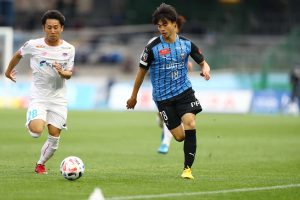
Kaoru Mitoma was playing for Tsukuba University / photograph: Kenzaburo Matsuoka
Japan’s got talent through its universities such as Kaoru Mitoma, a unique way in world football
Japan beat Germany and Spain to reach the round of 16 at the Qatar World Cup. Did you know that the Japan squad was made up of a number of university graduates, including Kaoru Mitoma?
There were nine university graduates in total, including former Inter Milan player Yuto Nagatomo, Stade de Reims’ speedster Jun-ya Ito, Sporting CP’s Hidemasa Morita, Belgium league’s second-highest scorer this season Ayase Ueda, and defender Shogo Taniguchi who graduated from Tsukuba University like Mitoma.
Then, have there always been many university graduates in the national team? The answer is yes and no.
If we look into the Japan squad at the 1998 World Cup in France, Japan’s first appearance, we find that there were defender Masami Ihara and striker Masashi Nakayama, both from Tsukuba University, as well as Hiroshi Nanami from Juntendo University who used to play for Serie A side Venezia. Also, midfield stalwart Toshihiro Yamaguchi and others make it a total of nine players graduated from universities, the same number as in 2022.
The situation changed, however, drastically when the J.League started in 1993. With an increasing number of players entering the professional clubs directly from the academies of J.League clubs and high schools, the number of top players going on to university plummeted.
For example, at the Japan-Korea World Cup in 2002, there were only two players – Nakayama and defender Tsuneyasu Miyamoto – and at the 2006 and 2010 tournaments, there were three. The trend of only two or three university graduates in Japan’s national team continued until the 2018 tournament in Russia.
But then why has the number of university graduates on the national team increased again?
Mitoma once turned down the offer to join Kawasaki
One reason is the structural problem in Japanese football, where many 18-year-old players who have just turned professional lose their chance to play. Even Mitoma said about his reasons for refusing to be promoted to Kawasaki’s first team in 2016: “I can’t make it as a professional player now. I want to improve at (the Tsukuba) University and try again in four years time”. He turned down the offer to join Kawasaki’s first team because he had seen his seniors from the same youth team, likes of Ko Itakura and Koji Miyoshi, failed to get a chance to play for the team.
The J.League stopped having satellite leagues (for second teams) in 2009 due to clubs’ costs and administrative burdens. And although some clubs have organised under-23 teams to compete in J3, only a small proportion of them do so. As a result, many players who turned professional at the age of 18 do not get enough opportunities to play.
On the other hand, university football is improving year by year. The coaching and training environment at universities are so high level that some of the top universities could surpass that of professional clubs in lower categories. Also, the management of leagues and other competitions is well organised. Another attraction is that if you don’t become a professional player, you can still get a bachelor’s degree, meaning you can have options.
Furthermore, a number of success stories push players towards the university route. Despite a four-year delay in the start of their professional careers, there are many examples of players overcoming the disadvantage and making the step up, from university to joining a J.League club, to European club, then to a European powerhouse. Such is the case with Ito and Morita, both of whom qualified for the Champions League in recent seasons.
This is why the number of university graduates is increasing in the Japan national team.


